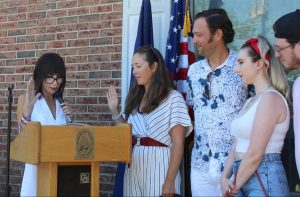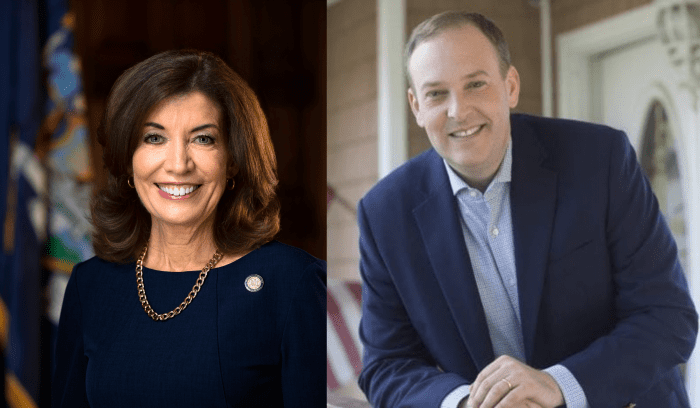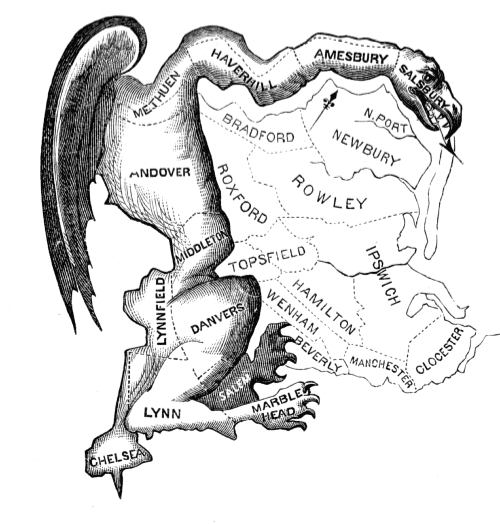How changing political boundaries can have real consequences for voters and their representatives
Redistricting is shaking up this election season.
Redistricting is the process by which new political boundaries are drawn to reflect the changes in populations across regions and states. New congressional districts, as well as state Senate and Assembly districts, are redrawn by state Legislatures every 10 years to accord with the most recent U.S. Census results.
‘Government at its worst.’
— Mario Mattera
This year, a cloud of uncertainty was placed over the electoral process when the state Court of Appeals blocked the New York State Legislature’s plans for redrawn district maps. The majority 4-3 decision sent the responsibility for redrawing the lines to an out-of-state independent commission.
State Sen. Mario Mattera (R-St. James), whose District 2 was altered significantly under the new lines, accused the majority in the state Legislature of attempting to gerrymander his district.
“What happened was — and I’m going to say this — the Democrats went in and gerrymandered the lines in the Senate and the congressional lines,” he said.
Unlike the district lines for the state Assembly, which Mattera suggested were worked out through a series of compromises between party leaders, the state Senate could not find a working agreement for new lines. The state senator also said that the lines could have been revised before they went to court, but the majority objected, hoping to win a favorable opinion for its unfair district maps.
“The judges ruled it gerrymandering, so it went to an outside commission called Special Masters, out of Pennsylvania, and it cost the taxpayers money to do this,” he said.
Mattera expressed frustration at the process, which he said wasted time and taxpayer dollars unnecessarily. He called the recent redistricting process “government at its worst.”
‘I’m never disappointed when the process is done fairly and when it’s done by a bipartisan group that is drawing the lines.’ — Jodi Giglio
New boundaries, altered communities
Under the new district maps, people in communities throughout Long Island will see major changes this year in their political representation. Mattera, whose district currently includes Setauket, Stony Brook and Old Field, will no longer represent those areas after this year.
“Even though, as a Republican, I wasn’t getting the best results out of Setauket and Stony Brook, I still loved my district,” he said. “I did very well in knowing the people and getting to know everybody, and now I’ve lost all of the Township of Brookhaven.”
Mattera is not alone in losing a significant portion of his current constituency. State leaders all across the Island have had their district lines redrawn as well.
“Southold in its entirety has been taken away from Assembly District 2 and has been placed in Assembly District 1,” said state Assemblywoman Jodi Giglio (R-Riverhead), who represents the 2nd District.
Despite losing Southold, Giglio is not disappointed by the changes in her district. She considered the redrawing of the Assembly lines a product of bipartisan negotiations and was glad to pick up new constituencies elsewhere.
“I’m never disappointed when the process is done fairly and when it’s done by a bipartisan group that is drawing the lines,” she said, adding, “I was pleased to pick up many people in the 2nd Assembly District and will continue to work for the people of Southold as I have grown very close to them.”
‘It’s a fact of life.’
— Helmut Norpoth
Redistricting, past and future
Helmut Norpoth, professor in the Department of Political Science at Stony Brook University, detailed the long history of partisan squabbles over district lines. He said gerrymandering has existed since at least the early 19th century.
The word “gerrymander” was created after the infamous Massachusetts Gov. Elbridge Gerry, a Founding Father and later vice president who first employed the tactic to create bizarrely shaped state senate districts. Norpoth said gerrymandering has been around “forever” and that “it’s a fact of life” whenever district maps are redrawn.
Norpoth and two of his students recently submitted a proposal to the New York State Independent Redistricting Commission. Their work is centered around making district maps fairer and elections more competitive.
“One of the requirements that we followed in our proposal is to keep communities intact and minimize any splitting of a natural community into different districts,” Norpoth said. Districts “have to be contiguous, they have to be compact. They have to be as competitive as possible, so that the balance can give both parties a chance.” He added, “There are so many different angles that you have to abide by. It’s sort of a magic act to put it all together.”
‘It’s becoming clear that it’s easier to draw unfair districts.’ — Robert Kelly
While there are so many variables considered while drawing district lines, supercomputing may help to speed up and simplify the process. Robert Kelly, professor in the Department of Computer Science at SBU, focuses on automated redistricting, which uses a mathematical formulation to generate district lines based on a wide range of constraints.
“That allows us to look at, for a given state, what the constraints are in redistricting, whether they be constraints by the state constitution, state laws or constraints given by federal court rulings,” he said. “With that, we can formulate a way to evaluate the quality of the given redistricting plan and then we can try to optimize that result.”
While advancements in computer programming and supercomputing are helping researchers improve redistricting models, Kelly acknowledged that they can also be used for nefarious purposes.
“It’s becoming clear that it’s easier to draw unfair districts,” he said. “The conclusion would be that with the availability of so much digital data that allows you to predict the voting patterns of individual voters and allows you to manipulate these district boundaries, it is creating a situation where more and more states are creating district boundaries that favor the political party that happens to be in power in the given state.”
With so much controversy today surrounding redistricting, it is questionable whether the problems of partisan gerrymandering will ever go away. Despite considerable effort by researchers like Norpoth and Kelly, conflict over district boundaries may be a feature inherent to any system that requires those lines to be redrawn.
When asked whether the redistricting process could ever become fairer, Kelly said, “Yes, I believe it could be more fair. … But would I predict that would ever happen? I would not bet on it.”


















